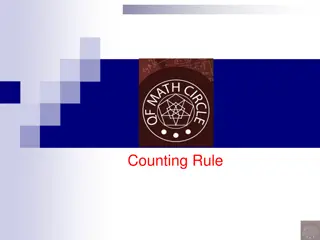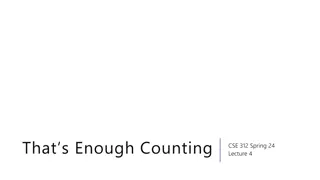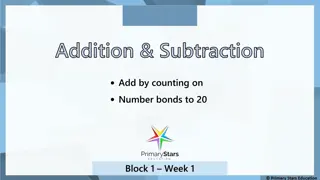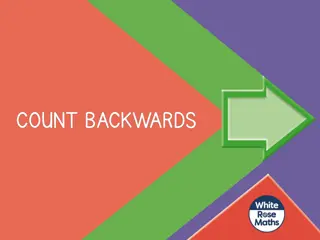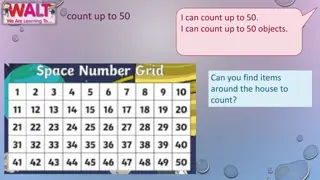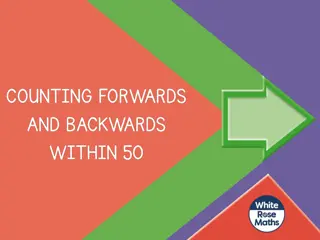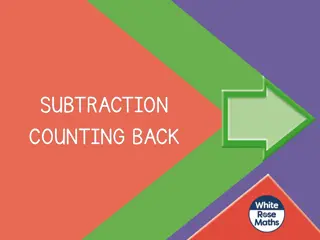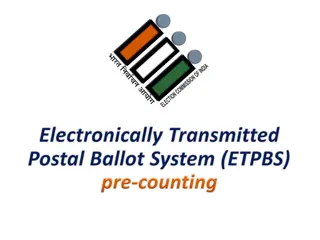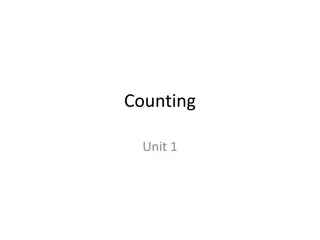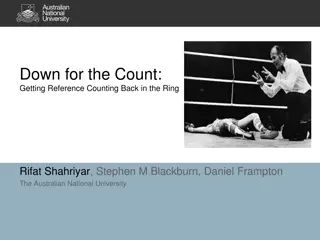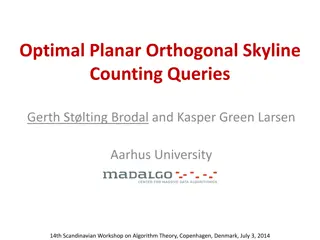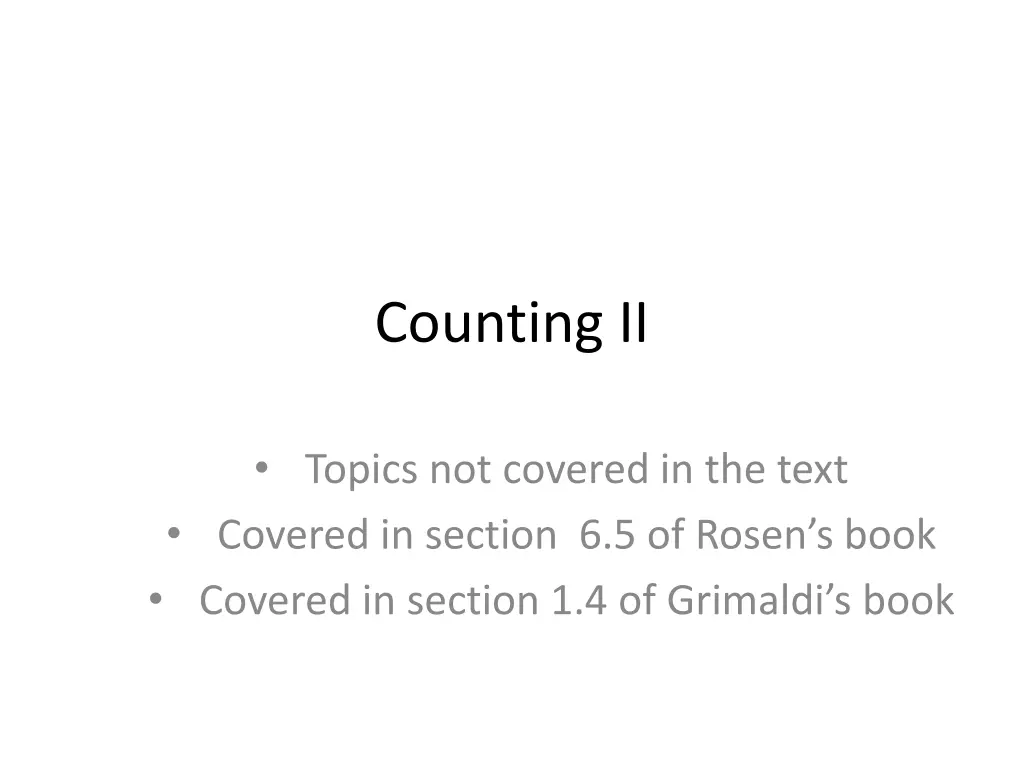
Permutations Explained with Examples in Counting II
Learn about permutations in counting with a focus on indistinguishable objects through examples like reordering the letters of a word. Understand how the order of objects impacts permutations and how to calculate distinct permutations effectively.
Download Presentation

Please find below an Image/Link to download the presentation.
The content on the website is provided AS IS for your information and personal use only. It may not be sold, licensed, or shared on other websites without obtaining consent from the author. If you encounter any issues during the download, it is possible that the publisher has removed the file from their server.
You are allowed to download the files provided on this website for personal or commercial use, subject to the condition that they are used lawfully. All files are the property of their respective owners.
The content on the website is provided AS IS for your information and personal use only. It may not be sold, licensed, or shared on other websites without obtaining consent from the author.
E N D
Presentation Transcript
Counting II Topics not covered in the text Covered in section 6.5 of Rosen s book Covered in section 1.4 of Grimaldi s book
Permutations A k-permutations of a set of n objects is the same as a length-k lists. Here the order of the objects is important. The number of k-permutations of n objects with repetition is nk. The number of k-permutation of n objects without repetition is . We write
Permutations with indistinguishable objects Example: How many permutations one can make by reordering the letters of the word JESSEE ? (JESSEE and SJESEE are two different lists (permutations))
Permutations with indistinguishable objects Example: How many permutations one can make by reordering the letters of the word JESSEE ? (JESSEE and SJESEE are two different lists (permutations)) First Method: We first indicate 3 Es as E1, E2, E3and two Ss as S1, S2. Thus JESSEE can be written as JE1S1S2E2E3.
Permutations with indistinguishable objects Example: How many permutations one can make by reordering the letters of the word JESSEE ? (JESSEE and SJESEE are two different lists (permutations)) First Method: We first indicate 3 Es as E1, E2, E3and two Ss as S1, S2. Thus JESSEE can be written as JE1S1S2E2E3. If three Es and two Ss are treated as distinct, the number of 6- permutations is 6!. Note that JE1S1S2E2E3 and JE1S2S1E2E3are the same if two Ss are not distinct. The number of distinct permutations is
Permutations with indistinguishable objects Example: How many permutations one can make by reordering the letters of the word JESSEE ? (JESSEE and SJESEE are two different lists (permutations)) Second Method: The word JESSEE contains 3 Es, 2 Ss and one J.
Permutations with indistinguishable objects Example: How many permutations one can make by reordering the letters of the word JESSEE ? (JESSEE and SJESEE are two different lists (permutations)) Second Method: The word JESSEE contains 3 Es, 2 Ss and one J. We can place 3 Es in 6 places in C(6,3) different ways.
Permutations with indistinguishable objects Example: How many permutations one can make by reordering the letters of the word JESSEE ? (JESSEE and SJESEE are two different lists (permutations)) Second Method: The word JESSEE contains 3 Es, 2 Ss and one J. We can place 3 Es in 6 places in C(6,3) different ways. There are three more positions to fill once Es are placed.
Permutations with indistinguishable objects Example: How many permutations one can make by reordering the letters of the word JESSEE ? (JESSEE and SJESEE are two different lists (permutations)) Second Method: The word JESSEE contains 3 Es, 2 Ss and one J. We can place 3 Es in 6 places in C(6,3) different ways. There are three more positions to fill once Es are placed. In C(3,2) ways we can place 2Ss in three positions. After all these, J has one (C(1,1)) position to go.
Permutations with indistinguishable objects Example: How many permutations one can make by reordering the letters of the word JESSEE ? (JESSEE and SJESEE are two different lists (permutations)) Second Method: The word JESSEE contains 3 Es, 2 Ss and one J. We can place 3 Es in 6 places in C(6,3) different ways. There are three more positions to fill once Es are placed. In C(3,2) ways we can place 2Ss in three positions. After all these, J has one (C(1,1)) position to go. The total number of permutations of the letters of JESSEE is
Permutations with indistinguishable objects Theorem: The number of different permutations of n objects where there are n1objects of Type 1 (non- distinct), n2objects of Type 2 (non-distinct), ., ntobjects of Type t (non-distinct), and , is
Combinations A k-combination of a set of n objects is an unordered selection of k elements from the set. When the elements are not repeated, a k-combination is a size- k subset. We have seen that
Combinations with repetitions We consider the case when an object is selected repeatedly. Example: Consider a set A = {a,b,c,d}. We select two objects from A. We now consider the following four cases.
4-permutations without repetitions: P(4,2) = 12 possible cases.
4-combinations without repetitions: C(4,2) = 6 possible cases.
4-combinations with repetitions: C(5,3) = 10 possible cases.
4-combinations with repetitions: C(5,3) = 10 possible cases. Note that combinations with repetitions do not correspond to subsets of a set.
Combinations with repetitions Consider the following problem known as distribution of money. We have n pennies that we want to distribute to k kids. Each child gets at least one penny. How many ways can we distribute the money?
Combinations with repetitions Consider the following problem known as distribution of money. We have n pennies that we want to distribute to k kids. Each child gets at least one penny. How many ways can we distribute the money? Kids are distinct, but pennies are not. For n=6 and k=3, (1,1,4), (2,3,1) are distinct ways. All solutions: (1,1,4), (1,2,3), (1,3,2), (1,4,1),(2,1,3), (2,2,2), (2,3,1), (3,1,2), (3,2,1), (4,1,1)
Combinations with repetitions Consider the following problem known as distribution of money. We have n pennies that we want to distribute to k kids. Each child gets at least one penny. How many ways can we distribute the money? Kids are distinct, but pennies are not. For n=6 and k=3, (1,1,4), (2,3,1) are distinct ways. All solutions: (1,1,4), (1,2,3), (1,3,2), (1,4,1),(2,1,3), (2,2,2), (2,3,1), (3,1,2), (3,2,1), (4,1,1) There is only one way for kid 1 to get n1 pennies, kid-2 to get n2 pennies, ..... and so on where n1 + n2+ +nk =n
Distribution of money We have n pennies that we want to distribute to k kids. Each child gets at least one penny. How many ways can we distribute the money? Let us consider the following experiment. Line up the pennies (all are the same), order doesn t matter. x x x x x x x x x x x x x x x x x x x x x x x x x x x x x x x x (n pennies)
Distribution of money We have n pennies that we want to distribute to k kids. Each child gets at least one penny. How many ways can we distribute the money? Let us consider the following experiment. Line up the pennies (all are the same), order doesn t matter. x x x x x x x x x x x x x x x x x x x x x x x x x x x x x x x x (n pennies) Let the first child pick them from left to right. After a while we stop the kid. x x x x x x x x x x |x x x x x x x x x x x x x x x x x x x x x x (kid -1 gets these) (stop)
Distribution of money Line up the pennies (all are the same), order doesn t matter. x x x x x x x x x x x x x x x x x x x x x x x x x x x x x x x x (n pennies) Let the first child pick them from left to right. After a while we stop the kid. x x x x x x x x x x |x x x x x x x x x x x x x x x x x x x x x x (kid -1 gets these) (stop)
Distribution of money Line up the pennies (all are the same), order doesn t matter. x x x x x x x x x x x x x x x x x x x x x x x x x x x x x x x x (n pennies) Let the first child pick them from left to right. After a while we stop the kid. x x x x x x x x x x |x x x x x x x x x x x x x x x x x x x x x x (kid -1 gets these) (stop) Let the second child pick pennies starting from where kid-1 stopped. x x x x x x x x x x |x x x x x x x x x x x| x x x x x x x x x x x (kid -1 gets these) (kid-2 gets these)
Distribution of money Line up the pennies (all are the same), order doesn t matter. x x x x x x x x x x x x x x x x x x x x x x x x x x x x x x x x (n pennies) The distribution of money is determined by specifying where to start with a new child. The first child starts from 1. The other k-1 kids can enter at position 2, 3, 4, , n-1. This means that there are C(n-1,k-1) ways to chose an entry point.
Distribution of money There are C(n-1,k-1) ways to distribute n pennies to k kids with the constraint that each kid gets at least one penny.
Distribution of money (no restriction) Problem: Distribute n pennies to k kids with no restriction on whether a kid gets a penny or not. We use the following trick: We borrow one penny from each kid, and then distribute (n+k) pennies to k kids such that each kid gets at least one penny. There are C(n+k-1,k-1) ways to distribute n pennies to k kids with no restriction.
Combinations with repetitions Given n distinct objects, select k objects where repetitions are allowed and the order of selecting objects is not important. (Note that k could be larger than n.) Here kids are n objects, and pennies are the k objects to be selected. The number of possible k-combinations is C(#kids + #pennies -1, #kids -1) = C(k+n-1, n-1)
Permutations and combinations with and without repetitions.
Number of integer solutions Problem: Let xi , 1 i n be n nonnegative integer variables. Determine all integer solutions to the equation x1 + x2+ + xn = m where xi 0 for all 1 i n. Suppose n=4, and m=7 x1=3, x2=3, x3=0, x4=1 is one solution to the equation. x1=1, x2=0, x3=3, x4=3 is another different solution. A possible interpretation for the solution x1=3, x2=3, x3=0, x4=1 is that we are distributing 7 pennies (identical) among 4 kids (distinct). We have given 3 pennies each to kid 1 and kid 2, nothing to the third kid, and kid 4 gets one penny.
Number of integer solutions Problem: Let xi , 1 i n be n nonnegative integer variables. Determine all integer solutions to the equation x1 + x2+ + xn = m where xi 0 for all 1 i n. m = # of pennies; n = # of kids; no restriction (i.e. a kid can get no penny) Total number of integral solutions = C(n+m-1, n-1)
It is important to recognize the equivalence of the following The number of integer solutions of the equation x1 + x2+ + xn = m where xi 0 for all 1 i n. The number of choices, with repetitions, of size m from a collection of n objects. The number of choices of distributing m pennies to n kids with no restriction (i.e. a kid can get zero penny). The number of ways of placing m balls in n distinct bins.
Example A doughnut shop has plain doughnuts, cherry doughnuts, chocolate doughnuts, almond doughnuts, apple doughnuts, broccoli doughnuts. How many ways are there to choose: (a) a dozen doughnuts?
Example A doughnut shop has plain doughnuts, cherry doughnuts, chocolate doughnuts, almond doughnuts, apple doughnuts, broccoli doughnuts. How many ways are there to choose: (a) a dozen doughnuts? 12 indistinguishable balls and 6 bins, or 12 pennies and 6 kids Ans: C(6+12-1,6-1) = C(17,5) = C(17, 12)
Example A doughnut shop has plain doughnuts, cherry doughnuts, chocolate doughnuts, almond doughnuts, apple doughnuts, broccoli doughnuts. How many ways are there to choose: (b) three dozen doughnuts?
Example A doughnut shop has plain doughnuts, cherry doughnuts, chocolate doughnuts, almond doughnuts, apple doughnuts, broccoli doughnuts. How many ways are there to choose: (b) three dozen doughnuts? 36 doughnut 36 indistinguishable balls and 6 bins, or 36 pennies and 6 kids Ans: C(6+36-1,6-1) = C(41,5) = C(41,36)
Example A doughnut shop has plain doughnuts, cherry doughnuts, chocolate doughnuts, almond doughnuts, apple doughnuts, broccoli doughnuts. How many ways are there to choose: (c) two dozen doughnuts with at least two of each kind?
Example A doughnut shop has plain doughnuts, cherry doughnuts, chocolate doughnuts, almond doughnuts, apple doughnuts, broccoli doughnuts. How many ways are there to choose: (c) two dozen doughnuts with at least two of each kind? Pick first two of each kind . Thus the number is the number of ways of choosing the remaining dozen. Same as question (a).
Example A doughnut shop has plain doughnuts, cherry doughnuts, chocolate doughnuts, almond doughnuts, apple doughnuts, broccoli doughnuts. How many ways are there to choose: (d) two dozen doughnuts with no more than two broccoli doughnuts?
Example A doughnut shop has plain doughnuts, cherry doughnuts, chocolate doughnuts, almond doughnuts, apple doughnuts, broccoli doughnuts. How many ways are there to choose: (d) two dozen doughnuts with no more than two broccoli doughnuts? We will add up three cases: no broccoli doughnut, exactly one broccoli doughnut, exactly two broccoli doughnuts. These numbers are: C(5 + 24 -1, 5-1) (0 broccoli doughnut); C(5+23-1, 5-1) (1 broccoli doughnut); C(5+22-1,5-1) (2 broccoli doughnuts)
Example A doughnut shop has plain doughnuts, cherry doughnuts, chocolate doughnuts, almond doughnuts, apple doughnuts, broccoli doughnuts. How many ways are there to choose: (e) two dozen doughnuts at least five chocolate doughnuts and at least three almond doughnuts?
Example A doughnut shop has plain doughnuts, cherry doughnuts, chocolate doughnuts, almond doughnuts, apple doughnuts, broccoli doughnuts. How many ways are there to choose: (e) two dozen doughnuts at least five chocolate doughnuts and at least three almond doughnuts? We have already chosen the first 8, so need to select the remaining 16. There are C(6+16-1,6-1) ways to do this.
Example A doughnut shop has plain doughnuts, cherry doughnuts, chocolate doughnuts, almond doughnuts, apple doughnuts, broccoli doughnuts. How many ways are there to choose: (e) two dozen doughnuts with at least one plain, at least two cherry, at least three chocolate, at least one almond, at least two apple, no more than three broccoli doughnuts?
Example A doughnut shop has plain doughnuts, cherry doughnuts, chocolate doughnuts, almond doughnuts, apple doughnuts, broccoli doughnuts. How many ways are there to choose: (e) two dozen doughnuts with at least one plain, at least two cherry, at least three chocolate, at least one almond, at least two apple, no more than three broccoli doughnuts? We have already chosen the first nine doughnuts. We need determine the ways to distribute 15 doughnuts without choosing more than 3 broccoli doughnuts. The answer is C(5+15-1,5-1) + C(5+14-1,5-1) + C(5+13-1,5-1) + C(5+12-1, 5-1).
Example In bridge, the 52 cards are dealt to 4 players. How many different ways to deal bridge hands?
Example In bridge, the 52 cards are dealt to 4 players. How many different ways to deal bridge hands? The answer is: C(52,13)*C(39,13)*C(26,13)*C(13,13)
Example How many terms are there in the expansion of (w + x + y + z)100?
Example How many terms are there in the expansion of (w + x + y + z)100? each term of in the expansion of (w + x + y + z)100 is of the form wa xb yc zd where a +b + c + d =100 where a, b, c, d are nonnegative integers. Therefore, the answer is C(4 + 100 -1, 4 1).


